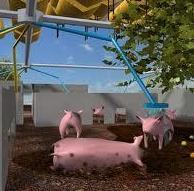
Meat production is one of the bigger emitters of carbon. We either need to change our consumption pattern or we need to find way to do sustainable farming. MVRDV did a study about 10 years ago to get a discussion going. Recently, in the Netherlands this option seems to be taken seriously as an alternative to the traditional way of pig farming. 10 years ago the issue was not as much about carbon emissions but more on food safety. Text and pictures by MVRDV.
In 2000, pork was the most consumed form of meat at 80 billion kg per year. Recent animal diseases such as Swine Fever and Foot and Mouth disease are raising serious questions about pork production and consumption. It is evident that the current pork industry cannot proceed in the same way without causing many casualties.
Two opposing reactions can be imagined. Either we change our consumption pattern and become instant vegetarians or we change the production methods and demand biological farming.
Let us assume that we remain pork-eaters. Do we then have enough space for biological pig farming?
With a production of 16,5 million tons of pork, The Netherlands is the chief exporter of pork within the European Union. In 1999, 15.2 million pigs and 15.5 million humans officially inhabited The Netherlands. One pig needs an area of 664 m2, including current food processing: composed of 50% intensive grain production and 50% industrial by-products.
In the case of organic farming, pigs would be fed with 100% grain, leading to a required 130% more field surface due to the reduced grain production. This would cause a demand of 1726 m2 per pig, including the organic food processing. This would mean that there would be only 774 m2 per person left for other activities. In other words, 75 % of the Netherlands would be dedicated to pigs.
Can we combine organic farming with a further concentration of the production-activities so that there will be enough space for other activities? Is it possible to compact all the pig production within concentrated farms, therefore avoiding unnecessary transportation and distribution, and thereby reducing the spread of diseases? Can we through concentrated farming, create the economical critical mass to allow for a communal slaughterhouse, a self-sufficient fertiliser recycler and a central food core, so as to solve the various problems found in the pig-industry?

Comments by our Users
Be the first to write a comment for this item.